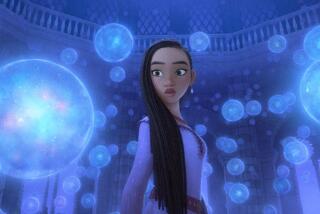TV Reviews : The Magic Fails to Work in Disney’s ‘Polly’ Fairy Tale
- Share via
“Polly” is the worst kind of fairy tale, one that doesn’t seem to know it’s a fairy tale.
Airing at 7 p.m. Sunday as part of NBC’s “The Magical World of Disney” (on Channels 4, 36 and 39), it’s also two hours of ooze, an ambitious but inferior musical adaptation of “Pollyanna,” a 1960 theatrical film starring a young Hayley Mills as a girl who spreads her own brand of joy to a suspicious New England town at the turn of the century.
The differences in the two movies are significant. “Polly” not only adds music, but also shifts the location and time to an Alabama town in the 1950s, and unlike “Pollyanna,” which was virtually all white, its cast is nearly all black.
In some ways this is family. The script is written by executive producer William Blinn, who produced the TV series “Fame.” “Polly” director-choreographer Debbie Allen also directed, choreographed and starred in “Fame.” Her sister, Phylicia Rashad of “The Cosby Show,” plays pivotal character Aunt Polly, “the richest black lady in the county.” And Keshia Knight Pulliam, who plays Rashad’s daughter on “The Cosby Show,” stars here as Aunt Polly’s bubbly niece little Polly, whose arrival from Detroit ultimately transforms the town and her rigid, authoritarian aunt.
Watching it all happen is something less than great fun, for the story is flat, maudlin and without passion, the characters cardboard and the songs--although arranged by Harold Wheeler (“The Whiz,” “Dreamgirls”)--mostly forgettable. The one exception is “Stand Up,” a rousing, joyous gospel production number written by Allen and her husband, Norm Nixon. It’s the only time when the characters seem even to sweat.
Rashad is suitably stern, but the only actor who injects much vigor is Dorian Harewood as Miss Polly’s romantic interest, Dr. Shannon. Played by Celeste Holm, meanwhile, the story’s only significant white character is as absurdly simplistic as the plot.
“Polly” is in a sort of history warp, its setting a hermetically sealed black enclave that seems virtually untouched by the white racism and black economic bleakness that typified Alabama in the ‘50s. It seems that the “white folks” live on the other side of a creek whose bridge was burned down 17 years ago, and unlike other white Alabamans of the times show no interest in oppressing and exploiting their black neighbors. In this pristine atmosphere, segregation seems almost idyllic, a misleading message for the young audience targeted by “The Magical World of Disney.”
Worst of all here is the all-wise little Polly, a 10-year-old so gratingly precious and saccharine that she makes Shirley Temple seem like Lucretia Borgia. Some magic.
More to Read
The complete guide to home viewing
Get Screen Gab for everything about the TV shows and streaming movies everyone’s talking about.
You may occasionally receive promotional content from the Los Angeles Times.





